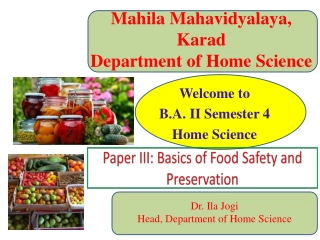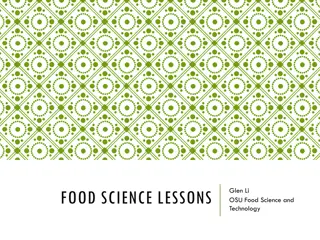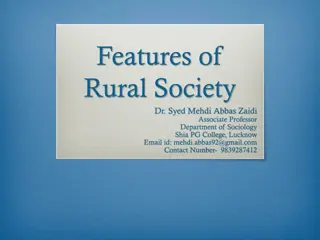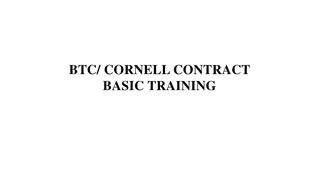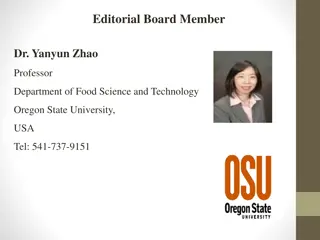Dr. Syed S.H. Rizvi: Professor of Food Science at Cornell University
Dr. Syed S.H. Rizvi is an esteemed International Professor of Food Process Engineering at Cornell University, USA. With a strong background in food science and bioseparation processes, he has made significant contributions to the field through his research, publications, and role as Editor in Chief. His work in food rheology highlights the importance of understanding the deformation and flow of matter in food manufacturing and processing.
Download Presentation

Please find below an Image/Link to download the presentation.
The content on the website is provided AS IS for your information and personal use only. It may not be sold, licensed, or shared on other websites without obtaining consent from the author. Download presentation by click this link. If you encounter any issues during the download, it is possible that the publisher has removed the file from their server.
E N D
Presentation Transcript
Editorial Board Member Dr. Syed S H Rizvi Editor in Chief Professor Department of Food Science Cornell Univeristy, USA Tel: 607-327-1082 Fax: 607-254-4868
Biography Syed S H Rizvi is International Professor of Food Process Engineering and has served as Director of Graduate Studies at the Cornell Institute of Food Science. He has a Ph.D. from Ohio State University, a M. Eng. (Chemical Engineering) from the University of Toronto, and a B. Tech. from Panjab University, India. He teaches courses devoted to engineering and processing aspects of food science and related biomaterials. He has also serves as a Jefferson Science Fellow and Senior Science Adviser in the U.S. Department of State, 2007-2008.
Research Interest Bio separation processes, Physical and engineering properties, Supercritical fluids, Extrusion, Rheology and international developments.
Publications and Books Publications Sikin AM, Zoellner C, Rizvi SS (2013) Current Intervention Strategies for the Microbial Safety of Sprouts.. Journal of Food Protection. 76:2099-2123. Paraman I, Wagner ME, Rizvi SS (2012) Micronutrient and protein-fortified whole grain puffed rice made by supercritical fluid extrusion. Journal of Agricultural and Food Chemistry. 60:11188 11194. Manoi K, Rizvi SS (2010) Physicochemical characteristics of phosphorylated cross-linked starch produced by reactive supercritical fluid extrusion. Carbohydrate Polymers. 81:687-694. Book Rizvi SS (2010) Separation, extraction and concentration processes in the food, beverage and nutraceutical industries.. p. 665 Syed S.H. Rizvi (ed.), Wood head Publishing, Oxford, U.K.
Food Rheology Food Rheology a study of deformation and flow of matter (especially interesting in agricultural and biological materials). We encounter rheology in our daily life! We eat breakfast, perhaps using a range of spreads for toast, or perhaps we eat yoghurt with pieces of fruit suspended in it. We all have squeezed toothpaste tubes, kneaded bread dough or tried to rub skin lotion on our leg. Rheology is simply one way of describing those sensations!!
Importance of Food Rheology Food rheology is important in quality control during food manufacture and processing Long food can be stored The study of food rheology is more complicated than study in fields such as the rheology of polymers.
Rheology in Daily Life We normally take for granted a lot of things in life and these include some of the rheologicalevents . The pictures show the different roles of rheology in food and nonfood products.
Examples of Rheological Properties Viscosity Elasticity Peanut butter in the jar Ketchup is commonly used an example The textural properties of a peanut butter and jelly sandwich
Rheological and Functional Properties in Cheese Cheese Cheese is a nutritious Food made mostly from Cow s milk. Curded by Lactic Acid Bacteria It is a source of protein and calcium Containing additional nutrients Types of Cheese Asiago Cheese Bleu Cheese Goat Cheese Cream Cheese Vegetarian Cheese
Rheological Tests Three categories Empirical- supply basic single point information Imitative-try to imitate the forces and deformations associated with a specific process Fundamental- gives information as to the element properties of a material
Rheological Methods Small Strain Used to define both the elastic and the viscous nature of cheese. Cheese is a time dependent material Useful in understanding mechanisms of some endues functions. Used to determine changes caused by processing and storage parameters of cheeses Large Strain Used to determine cheese texture These measurements occur outside of linear viscoelastic region Characterize the non linear and fracture properties of the material Relate well to sensory properties since mastication is a large strain action
Factors affecting Rheological and Functional Properties Can be categorized as below Properties of milk Cheese composition Cheese making procedures Post manufacturing processes
Industrial Aspect of Rheology Responsible for any formulation, production, appearance, usage, and finally affect stability Affects final cost of product If a material is pumped, sprayed, extended, extruded, molded, coated, mixed, chewed, swallowed, rubbed, transported, stored, heated, cooled, aged Rheology is important
Examples of Complex Fluids Foods Emulsions (mayonnaise, ice cream) Foams (ice cream, whipped cream) Suspensions (mustard, chocolate) Gels (cheese) Bio fluids Suspension (blood) Gel (mucin) Solutions (spittle), etc.,
Thank You..! Thank You..!








